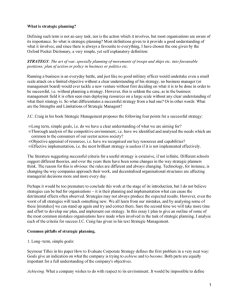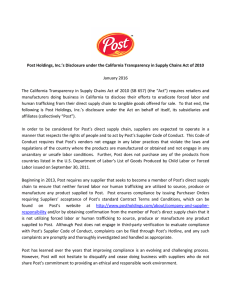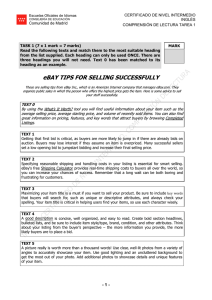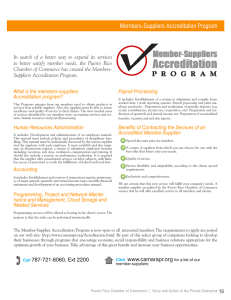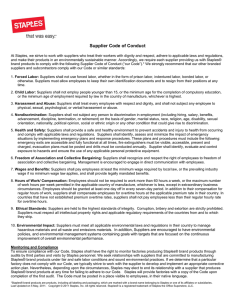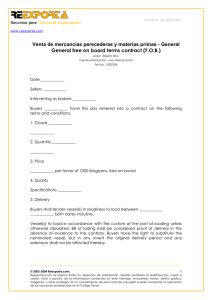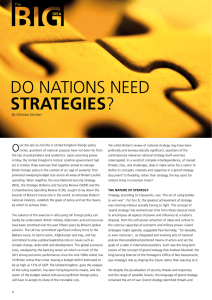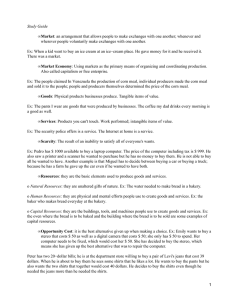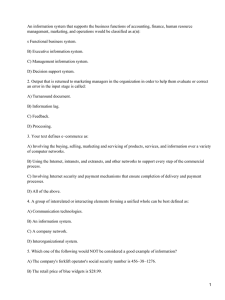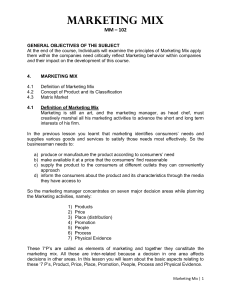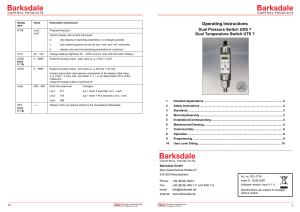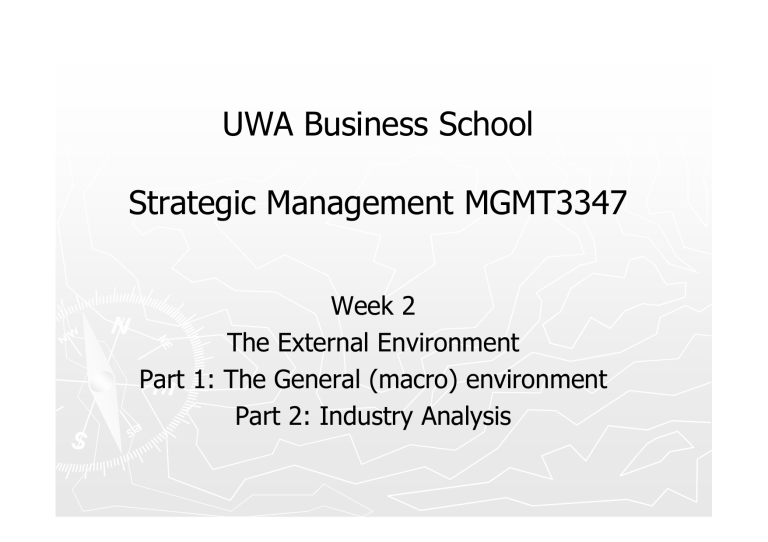
UWA Business School Strategic Management MGMT3347 Week 2 The External Environment Part 1: The General (macro) environment Part 2: Industry Analysis The strategic management process This week’s topic MGMT3347 Week 2 2 The external environment MGMT3347 Week 2 Source: Hanson et al (2017) 3 Elements of the external environment ► General environment Non industry specific Focused on the macro environmental factors that impact on all industries ► Industry environment Industry specific Focused on factors and conditions threatening a firm’s competitive position within an industry ► Competitor environment Focused on predicting the dynamics of competitors’ actions, responses and intentions MGMT3347 Week 2 4 Elements of the general (macro) environment 1. Demographic 2. Economic 3. Political and legal 4. Technology 5. Socio-cultural 6. Global forces 7. Physical MGMT3347 Week 2 5 The external environment ►A – – firm’s external environment creates: opportunities (e.g. the opportunity for BP to enter other global markets) threats (e.g. the possibility that additional regulations in its global markets will reduce opportunities for BP to extract oil and gas) ► Collectively, opportunities and threats affect a firm’s strategic actions MGMT3347 Week 2 6 Demographic ► Age structure.….implications? Shrinking workforce Older workforce Health care costs Retiring baby boomers New business opportunities ► Slow/negative growth rates in some countries ► Ethnic mix = workforce diversity ► Income distribution ► Geographic distribution MGMT3347 Week 2 7 Economic ► Economic climate Cycles of growth and contractions Current economic downturn.….implications? Low consumer confidence ► Higher unemployment rates ► Decreasing share prices ► Which industries are more susceptible to economic forces? ► Discretionary vs necessities Reserve Bank holds interest rate at 1.5% to increase growth in spending MGMT3347 Week 2 8 Political/Legal ► Government policies Anti-competitive practices (ACCC) Employment laws (e.g., maternity leave) Taxation laws (e.g., carbon tax, mining tax) Trade agreements (e.g., FTAs) Education policies Increasing attention on environmental issues: ► Kyoto MGMT3347 Protocol ► Garnaut Climate Change Review ► National Greenhouse and Energy Reporting Act 2007 Week 2 9 Socio-cultural ► Society’s attitudes and cultural values Attitudes about work/life balance, lifestyle, health, quality of life, freedom of choice, individuality, social and environmental responsibilities Consumer pressures for more information – product content; production process, unit pricing, product origins, etc Workplace ethnic and cultural diversity Shifts in product and service preference characteristics Shifts in work and career preferences MGMT3347 Week 2 10 Technology ► Impact of technological developments Internet technology, mobile and wireless communication ► New and multiple modes of communication ► Facebook, Twitter, Instagram, bloggers, review websites (eg, Tripadvisor) Greater and quicker diffusion of information and innovation ► Breaking down traditional barriers Global commerce; global outsourcing Technology convergence Blurring of industry boundaries Disruptive technology MGMT3347 Week 2 11 Global forces ► Globalisation of markets Global competition; global outsourcing; emergence of new markets ► Wars, terrorism, important political events, unstable political regimes ► Global financial crisis ► Global energy crisis Impact of oil prices on various industries ► Critical global markets – – MGMT3347 emerging countries and markets (BRIC) different cultural and institutional attributes Week 2 12 The Physical Environment ► ► The potential and actual changes in the physical environment and business practices that are intended to positively respond to and deal with those changes Key elements include: – energy consumption – practices used to develop energy sources – renewable energy efforts – minimising a firm’s environmental footprint – availability of water as a resource – producing environmentally friendly products – reacting to natural or man-made disasters – MGMT3347 E.g., Japan earthquakes affect local and global markets Week 2 13 Increasingly pressured and challenging world Economic Crisis Competition Natural disasters Climate change Fast changing technology Wars/conflicts Demands agility from firms Firms need to constantly learn from the environment MGMT3347 Week 2 14 Industry analysis ► An industry A group of companies offering products or services that are close substitutes for each other ► The purpose of industry analysis: To understand the structure and dynamics of the industry To understand the forces driving competition To identify threats and opportunities important to the firm MGMT3347 Week 2 15 The five forces model Source: Adapted from ME Porter, ‘How competence forces shape strategy’, Harvard Business Review, March– April 1979. Adapted and reprinted by permission of Harvard Business Review. © 1979 by the Harvard Business School Publishing Corporation; all rights reserved. MGMT3347 Week 2 16 Threat of new entrants ► ► Risk of new entrants depends on entry barriers: What are the entry barriers? Economies of scale Absolute cost advantages regardless of size (e.g., location) Capital requirements Switching costs due to customer loyalty Access to distribution channels Government policy, legal barriers Expected retaliation MGMT3347 Week 2 17 Bargaining power of buyers ► Buyers are powerful when: There are a few large buyers They purchase in large quantities Buyers can buy from multiple sources at once The products are undifferentiated (hence, low switching costs) They can vertically integrate backwards to compete with suppliers MGMT3347 Week 2 18 Bargaining power of suppliers ► Suppliers are powerful when: There is only a few large suppliers, i.e., lack of substitute suppliers Supplier’s products are critical to the buyers Supplier’s products have high switching costs The buyer is not an important customer to the supplier Suppliers can vertically integrate forward to compete with buyers and buyers can’t integrate backward to supply their own needs MGMT3347 Week 2 19 Threat of substitute products ► A threat when the substitute product comes closer to fulfilling a similar function to the original product ► A threat if there are low switching costs ► The existence of substitute products may create price limits on the original products MGMT3347 Week 2 20 Intensity of rivalry ► Concentration ► Rate of industry growth ► Extent of product differentiation The lower the differentiation, the lower the switching costs, more intense the rivalry ► High fixed costs ► High exit barriers ► High strategic stakes MGMT3347 Week 2 21 Interpreting Industry Analyses Low Barriers to Entry Suppliers and /or Buyers have strong positions Unattractive Industry Strong Threats from Substitutes Intense Rivalry MGMT3347 Week 2 22 Interpreting Industry Analyses (cont’d) High Barriers to Entry Suppliers and /or Buyers have weak positions Attractive Industry Few Threats from Substitutes Moderate Rivalry Among Competitors MGMT3347 Week 2 23 Limitations of the five forces model ► A static model (a snapshot of the industry today) ► Ignores the role of innovation which can change industry structure Eg: Apple, Netflix, Amazon.com; Ebay, Uber, Airbnb, etc ► Too much emphasis on industry structure Being in an attractive industry does not mean you will succeed Individual firm differences play a significant role (the resourcebased theory) ► Changes in industry structure The five forces will shift/change over time MGMT3347 Week 2 24 Globalisation and industry structure ► What are the effects of globalisation? Dispersing the production process Global markets, rather than national markets ► Competition does not stop at the national level Increased rate of innovation Decreasing trade barriers creates opportunities MGMT3347 Week 2 25 Asking the right questions about the industry ► What are the industry’s dominant features? ► What are the key factors for competitive success? ► What is competition like and how strong are each of the competitive forces? ► Which companies are in the strongest/weakest positions? ► What is causing the industry’s competitive structure and business environment to change? ► Is the industry attractive and what are the prospects for above-average profitability? Source: Thompson and Strickland, 2003 MGMT3347 Week 2 26 Next Week ► Lecture topic – The Internal environment ► Tutorial: Finalise your groups in your tutorial by next week (3-4 members only please!) Read Chap 2, LMS article (Porter’s 5-forces), and lecture notes Prepare Chap 2 review questions and the “Australian Supermarket” case (textbook) MGMT3347 Week 2 27
